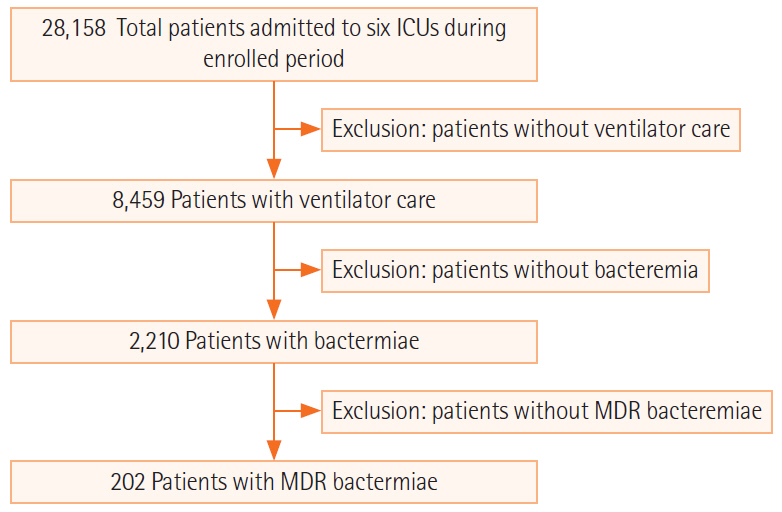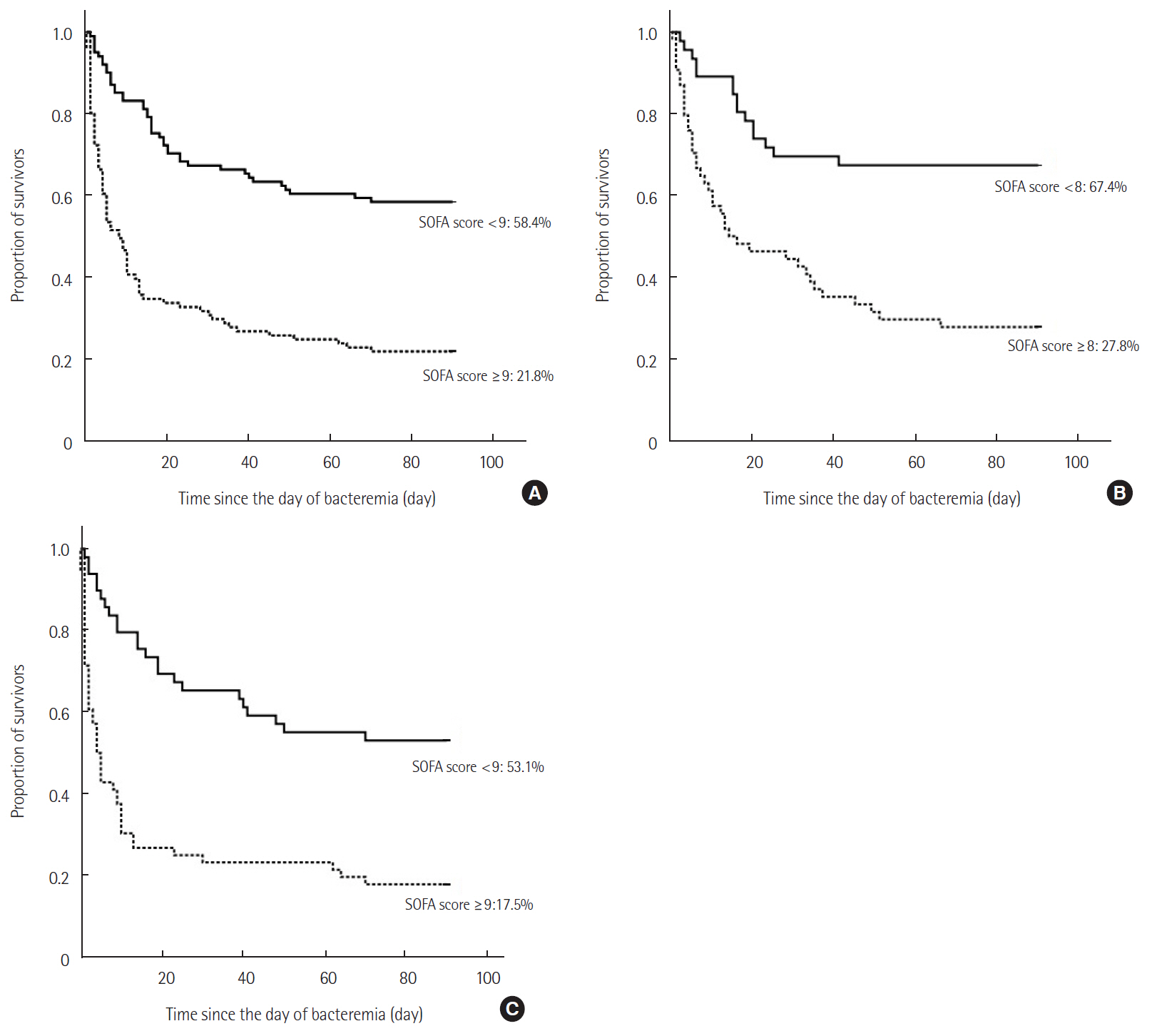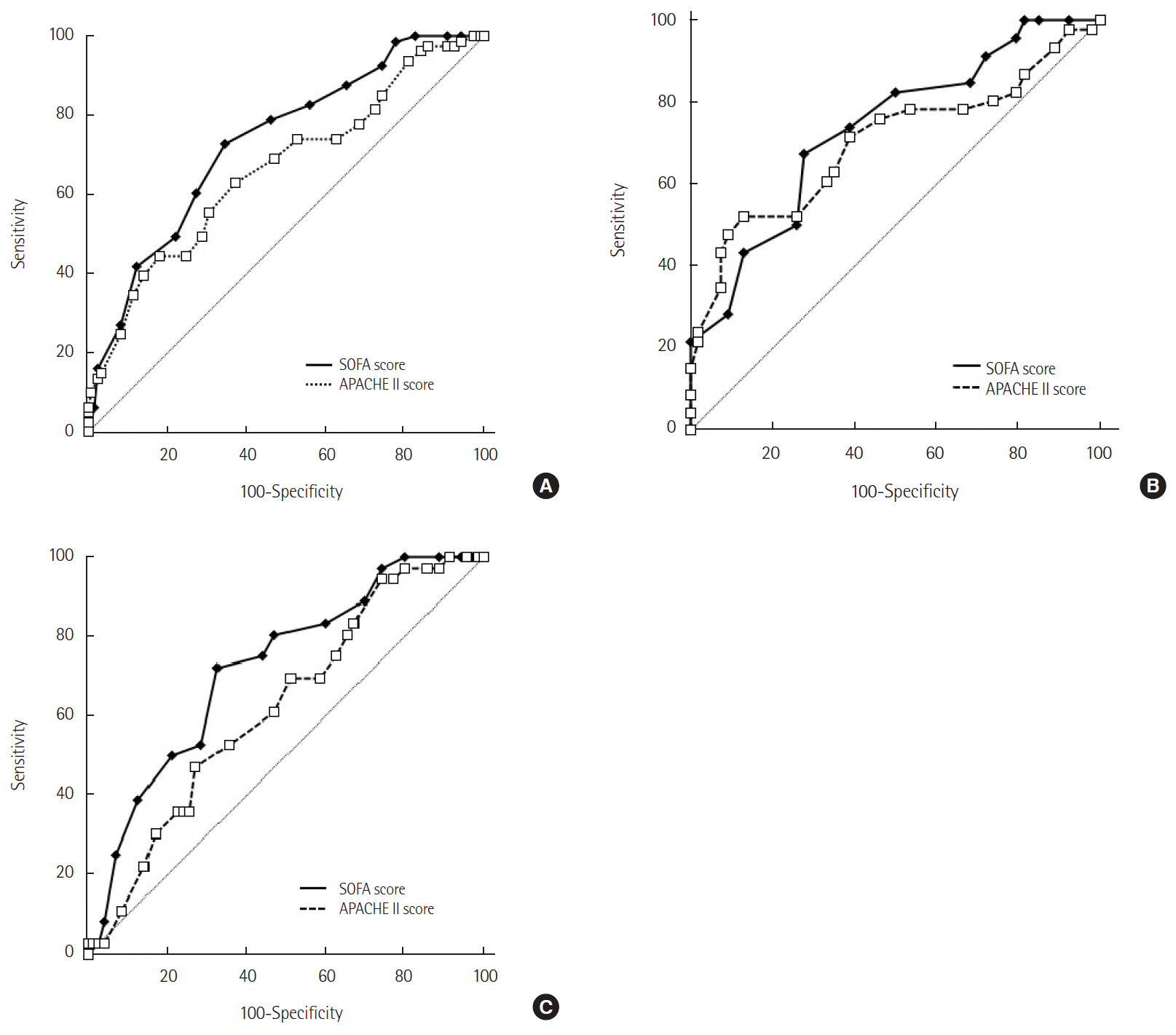Acute Crit Care.
2020 Aug;35(3):169-178. 10.4266/acc.2020.00143.
Sequential Organ Failure Assessment score as a predictor of mortality in ventilated patients with multidrug-resistant bacteremia
- Affiliations
-
- 1Division of Pulmonary, Allergy, and Critical Care Medicine, Department of Internal Medicine, Pusan National University School of Medicine, Busan, Korea
- KMID: 2506096
- DOI: http://doi.org/10.4266/acc.2020.00143
Abstract
- Background
The occurrence of multidrug-resistant (MDR) bacteremia in ventilated patients may be associated with a high mortality rate. We evaluated whether Sequential Organ Failure Assessment (SOFA) score on the day of bacteremia could predict 90-day mortality in these patients.
Methods
Data were obtained retrospectively from 202 patients (male, 60.4%; median age, 64 years) hospitalized at a single university-affiliated tertiary care hospital. All adult patients who had were ventilated and had one of the following six MDR bacteremias between March 2011 and February 2018 were enrolled: methicillin-resistant Staphylococcus aureus, extended-spectrum β-lactamase-producing Gram-negative bacteria (Escherichia coli and Klebsiella pneumonia), carbapenem-resistant Gram-negative rods (Acinetobacter baumannii and Pseudomonas aeruginosa), or vancomycin-resistant Enterococcus faecium.
Results
The overall 90-day mortality rate after the day of bacteremia was 59.9%. The areas under the receiver operating characteristic curves for the SOFA and Acute Physiology and Chronic Health Evaluation (APACHE) II scores were 0.732 (95% confidence interval [CI], 0.666 to 0.792; P < 0.001) and 0.662 (95% CI, 0.593 to 0.727; P < 0.001), respectively, with no difference between the two (P = 0.059). Also, the cutoff value of the SOFA score was 9 (based on Youden’s index). Multivariate Cox regression analysis showed that this cut-off value was significantly associated with higher mortality rate (hazard ratio, 2.886; 95% CI, 1.946 to 4.221;P < 0.001).
Conclusions
SOFA score measured on the day of bacteremia may be a useful prognostic indicator of 90-day mortality in ventilated patients with MDR bacteremia.
Keyword
Figure
Reference
-
1. Pulcini C, Defres S, Aggarwal I, Nathwani D, Davey P. Design of a ‘day 3 bundle’ to improve the reassessment of inpatient empirical antibiotic prescriptions. J Antimicrob Chemother. 2008; 61:1384–8.
Article2. Levy-Hara G, Amábile-Cuevas CF, Gould I, Hutchinson J, Abbo L, Saxynger L, et al. “Ten commandments” for the appropriate use of antibiotics by the practicing physician in an outpatient setting. Front Microbiol. 2011; 2:230.
Article3. Levy Hara G, Kanj SS, Pagani L, Abbo L, Endimiani A, Wertheim HF, et al. Ten key points for the appropriate use of antibiotics in hospitalised patients: a consensus from the Antimicrobial Stewardship and Resistance Working Groups of the International Society of Chemotherapy. Int J Antimicrob Agents. 2016; 48:239–46.
Article4. Magill SS, Edwards JR, Bamberg W, Beldavs ZG, Dumyati G, Kainer MA, et al. Multistate point-prevalence survey of health care-associated infections. N Engl J Med. 2014; 370:1198–208.
Article5. Magiorakos AP, Srinivasan A, Carey RB, Carmeli Y, Falagas ME, Giske CG, et al. Multidrug-resistant, extensively drug-resistant and pandrug-resistant bacteria: an international expert proposal for interim standard definitions for acquired resistance. Clin Microbiol Infect. 2012; 18:268–81.
Article6. Brusselaers N, Vogelaers D, Blot S. The rising problem of antimicrobial resistance in the intensive care unit. Ann Intensive Care. 2011; 1:47.
Article7. Kim JH, Hong SK, Kim KC, Lee MG, Lee KM, Jung SS, et al. Influence of full-time intensivist and the nurse-to-patient ratio on the implementation of severe sepsis bundles in Korean intensive care units. J Crit Care. 2012; 27:414.e11. 21.
Article8. Kwak SH, Jeong CW, Lee SH, Lee HJ, Koh Y. Current status of intensive care units registered as critical care subspecialty training hospitals in Korea. J Korean Med Sci. 2014; 29:431–7.
Article9. Lim CM, Kwak SH, Suh GY, Koh Y. Critical care in Korea: present and future. J Korean Med Sci. 2015; 30:1540–4.
Article10. Vincent JL, Moreno R, Takala J, Willatts S, De Mendonca A, Bruining H, et al. The SOFA (Sepsis-related Organ Failure Assessment) score to describe organ dysfunction/failure. On behalf of the Working Group on Sepsis-Related Problems of the European Society of Intensive Care Medicine. Intensive Care Med. 1996; 22:707–10.11. Singer M, Deutschman CS, Seymour CW, Shankar-Hari M, Annane D, Bauer M, et al. The third international consensus definitions for sepsis and septic shock (Sepsis-3). JAMA. 2016; 315:801–10.
Article12. Knaus WA, Draper EA, Wagner DP, Zimmerman JE. APACHE II: a severity of disease classification system. Crit Care Med. 1985; 13:818–29.13. Acute Respiratory Distress Syndrome Network, Brower RG, Matthay MA, Morris A, Schoenfeld D, Thompson BT, et al. Ventilation with lower tidal volumes as compared with traditional tidal volumes for acute lung injury and the acute respiratory distress syndrome. N Engl J Med. 2000; 342:1301–8.
Article14. Lockwood AM, Perez KK, Musick WL, Ikwuagwu JO, Attia E, Fasoranti OO, et al. Integrating rapid diagnostics and antimicrobial stewardship in two community hospitals improved process measures and antibiotic adjustment time. Infect Control Hosp Epidemiol. 2016; 37:425–32.
Article15. ARDS Definition Task Force, Ranieri VM, Rubenfeld GD, Thompson BT, Ferguson ND, Caldwell E, et al. Acute respiratory distress syndrome: the Berlin Definition. JAMA. 2012; 307:2526–33.16. Howard P, Pulcini C, Levy Hara G, West RM, Gould IM, Harbarth S, et al. An international cross-sectional survey of antimicrobial stewardship programmes in hospitals. J Antimicrob Chemother. 2015; 70:1245–55.
Article17. Perkins NJ, Schisterman EF. The inconsistency of “optimal” cutpoints obtained using two criteria based on the receiver operating characteristic curve. Am J Epidemiol. 2006; 163:670–5.
Article18. DeLong ER, DeLong DM, Clarke-Pearson DL. Comparing the areas under two or more correlated receiver operating characteristic curves: a nonparametric approach. Biometrics. 1988; 44:837–45.
Article19. Chen SJ, Chao TF, Chiang MC, Kuo SC, Chen LY, Yin TL, et al. Prediction of patient outcome from Acinetobacter baumannii bacteremia with Sequential Organ Failure Assessment (SOFA) and Acute Physiology and Chronic Health Evaluation (APACHE) II scores. Intern Med. 2011; 50:871–7.
Article20. Saunderson RB, Gouliouris T, Nickerson EK, Cartwright EJ, Kidney A, Aliyu SH, et al. Impact of routine bedside infectious disease consultation on clinical management and outcome of Staphylococcus aureus bacteraemia in adults. Clin Microbiol Infect. 2015; 21:779–85.
Article21. Fries BL, Licitra C, Crespo A, Akhter K, Busowski MT, Salazar D, et al. Infectious diseases consultation and the management of Staphylococcus aureus bacteremia. Clin Infect Dis. 2014; 58:598–9.
Article
- Full Text Links
- Actions
-
Cited
- CITED
-
- Close
- Share
- Similar articles
-
- Current Status and Survival Impact of Infectious Disease Consultation for Multidrug-Resistant Bacteremia in Ventilated Patients: A Single-Center Experience in Korea
- APACHE II Score and Multiple Organ Failure Score as Predictors of Mortality Rate of Critically Ill Patients
- Prevalence and predictors of multidrug-resistant bacteremia in liver cirrhosis
- Assessment of organ failure in sepsis patients in the emergency department: clinical evaluation, Sequential Organ Failure Assessment (SOFA) score, and future perspectives
- Early Changes in the Sequential Organ Failure Assessment (SOFA) Score as a Prognostic Factor in Acute Respiratory Failure in Children with Mechanical Ventilator Support




